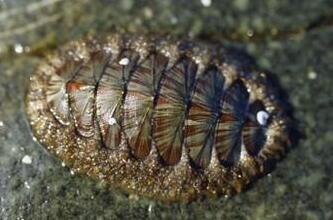Chitons are common marine mollusks mainly inhabiting intertidal and shallow subtidal worldwide. They, belonging to class Polyplacophora, can be recognized by their eight overlapping shell plates (also known as valves), which are firmly surrounded by a tough muscular girdle. Hainan Island and its vicinity comprise diverse habitats with a highly diverse marine fauna, while the chiton biodiversity of this area is poorly known.
Supported by the Bureau of International Cooperation Chinese Academy of Sciences and National Natural Science Foundation of China, scientists from the Institute of Oceanology of the Chinese Academy of Sciences (IOCAS) and Zoological Institute of the Russian Academy of Sciences organized a joint expedition to Hainan to study the chitons. Based on their cooperative study on samples from this expedition and historical collections, they comprehensively reported the fauna of the living chitons from this area for the first time. Their findings were published in Zootaxa https://biotaxa.org/Zootaxa/article/view/zootaxa.4564.1.1.
The present results showed that a total of 30 species belonging to 18 genera in seven families were recognized in the vicinity of Hainan Island by careful examination of valves, radulae, girdles and other morphological characters. Six species were reported for the first time from this area, i.e., Rhyssoplax venusta, Lucilina lamellosa, L. tenuicostata, L. tilbrooki, Onithochiton stracki and Acanthochitona intermedia. Several species names were also corrected: Craspedochiton laqueatus previously reported from there was re-identified as Acanthochitona lanae; Notoplax (Notoplax) sp. and Notoplax (Notoplax) formosa were both re-identified as Acanthochitona britayevi; Notoplax doederleini was re-identified as Acathochitona achates. In additions, Callochiton sp. and Plaxiphora sp. were identified as Callochiton multidentatus and Plaxiphora bucklandnicksi, respectively. Acanthochiton sp. from Xisha Islands was identified as A. intermedia. Acanthochitona rubrolineata and Acanthochitona bednalli were excluded from distribution to the South China Sea.
Dr. Junlong Zhang from IOCAS said, 'The eastern part of Hainan Island is influenced by the South China Sea Warm Current that contributes to the dispersal of larvae of warm water species to the north, up to Japan. The western part is located in the Beibu Gulf with relatively cold water in winter. Thus, Hainan Islands share many common species of chitons with Taiwan, Hong Kong, and Vietnam. In this region, we expect more species to be found in the future.'
When talking about his cooperation with Russian expert Dr. Boris Sirenko, Junlong said, 'I feel it is predestined. As half century ago, my doctoral supervisor late Academician Liu Ruiyu, had cooperated with his supervisor Prof. Gurjanova. Before we met, we didn’t know that. They organized Sino-Soviet joint expedition in 1950s and coauthored the first paper on marine benthic ecology of China.' The biodiversity of chitons in China is still poorly known with many misidentifications and potentially unreported species. The research team will continue their cooperation to conduct taxonomic study on chitons.

picture of chiton from web
|
|

Address: 7 Nanhai Road, Qingdao, Shandong 266071, China
Tel: 86-532-82898902 Fax: 86-532-82898612 E-mail: iocas@qdio.ac.cn


